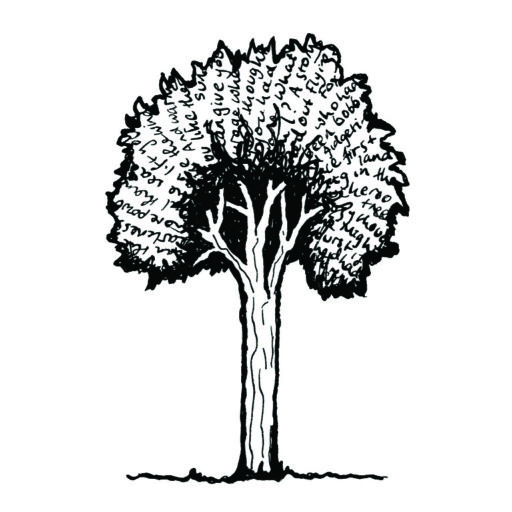
The black booyong (Argyrodendron actinophyllum), a common wet rainforest tree in south east Queensland. A little girl hiding among the roots gives an indication of scale. By Paula Peeters, pastel on paper.
The rainforest holds many secrets in its high vaulted green ceilings, swooping loops of vines, a million soft mossy pockets and damp rotting piles of leaves. So many tales to tell. Of tree and leaf, beast and bug, season and storm. This one is about the black booyong, and the bugs (more than 700 species) who call it home.
(By ‘bugs’ I mean arthropods, a term that includes insects, spiders, mites, and other more obscure creatures, like pseudoscorpions and amblypygids.)
In the late 1980s the rainforests of Mount Glorious in south-east Queensland were well-frequented by a PhD student from a Brisbane university. He studied the arthropods of the black booyong tree, Argyrodendron actinophyllum. These trees have buttress roots and rough-fissured brown bark. Their leaves are a spray of five to nine leaflets, attached to a central point, like fingers on a hand. If you go walking in the rainforest at Mount Glorious, or in Lamington National Park, you will walk under and beside these black booyongs, often some of the largest trees in the forest. And from a human’s humble perspective, barely a meter or so higher than the ground, there is little indication of the diverse, thriving bug community living in the rainforest canopy far above your head.
The student was from Switzerland and his name was Yves Basset. He climbed the trees and collected the arthropods. Day and night, over many months, and in different seasons, over 2 years. He collected over 50,000 individuals which represented 759 species. Nearly half of these species (309) were beetles. And these were all associated with just one tree, the black booyong.
In the warmer months, when the trees put on new leaves, there were more individuals and more species. Most of the critters were very small – between 2 and 4 mm, and 62% of them were less than 3.4 mm long. It probably makes sense that more small animals can live on plants than large animals, as there are more small hiding places than large ones.
The bug community of this subtropical rainforest tree had high numbers of sucking insects – those that feed on the sap of the tree – and plenty of spiders. In this way it was similar to the bug communities found on trees of temperate climates. But there were also lots of beetles and a high biomass of katydids, crickets and their relatives, features in common with the buglife collected from tropical rainforest trees.
Ants were rare, which is unusual in Australia. Yves thought that seasonal fluctuations in arthropod productivity – which was 60% lower in winter – might cause predatory ants to starve. Spiders might be the dominant predator in this system because they can survive long periods of starvation. Web-building spiders can also catch the flying insects that usually elude ants. Ants don’t generally prey much on spiders either, preferring soft-bodied insects (and presumably those without fangs or venom) such as aphids and caterpillars.
But not all insects fear ants: certain sap-suckers are tended and protected by them. These include the membracids and eurymelids which in Australia feed mostly on wattles and eucalypts. Not surprisingly, these insects were absent from the black booyongs, perhaps because of the low numbers of ants, or other traits of the tree, or a combination of both.
So next time you visit a forest, spare a thought for the arthropod world: the hundreds of different species way up there in the trees. All those complex machinations playing out above while we are happily oblivious below. You may rarely see the players as they are all so small. But there’s an awful lot going on, and that’s just in the black booyongs. How many other types of bugs live on the myriad other species of rainforest trees? What other interactions between predator and prey, insect and leaf, are taking place? But that is another story, for another day.
Refs: Basset and Kitching (1991) Species number, species abundance and body length of arboreal arthropods associated with an Australian rainforest tree. Ecological Entomology ; Basset (1991) The taxonomic composition of the arthropod fauna associated with an Australian rainforest tree. Australian Journal of Zoology
Read The strangler fig: everyone’s favorite killer for a story about a lethal rainforest tree and its animal accomplices.
Discover more from Paperbark Writer
Subscribe to get the latest posts sent to your email.


I enjoyed this fascinating article particularly as we often visit Mts Glorious and Nebo. This is nature writing at its best.
Thanks Mary – glad you enjoyed it